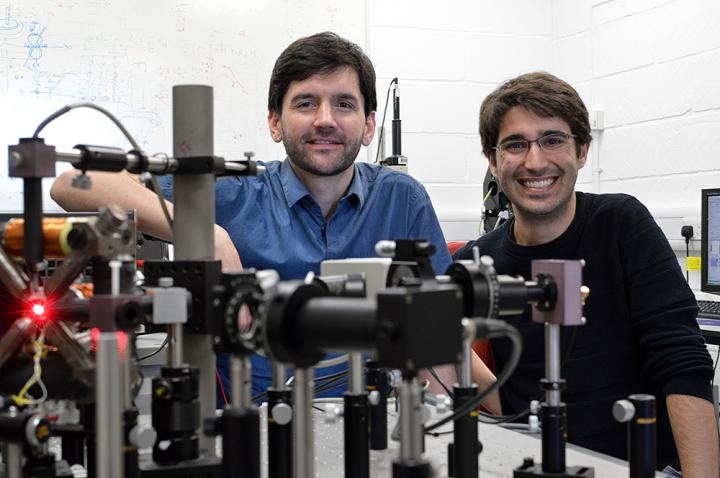Nov 16 2017
Since the late 60's electronic gadgets have stored and transmitted information (bits) in 2D circuits. Recently, a team of researchers at the University of Cambridge have been able to cross this barrier by developing a nanoscale magnetic circuit that can move information along the three dimensions of space.
This innovation could pave the way to a crucial increase in storage and processing capacities of electronic devices compared to those used presently.
 Amalio Fernández-Pacheco, principal investigator of the project (left) and Dédalo Sanz-Hernández, lead author of the work (right) posing with the optical system used at the University of Cambridge to read information from 3-D magnetic nanostructures. (CREDIT - Dédalo Sanz-Hernández)
Amalio Fernández-Pacheco, principal investigator of the project (left) and Dédalo Sanz-Hernández, lead author of the work (right) posing with the optical system used at the University of Cambridge to read information from 3-D magnetic nanostructures. (CREDIT - Dédalo Sanz-Hernández)
The information revolution that has changed society into what it currently is has been based on traditional printing of ever-shrinking electronic parts. With existing technologies reaching the boundaries of what Physics allows, researchers are beginning to seek the third dimension in a hunt for a route to carry on refining those electronic devices people have in their pockets.
In a new study published in the journal ACS Nano, a team of researchers from the University of Cambridge (UK) and TU Eindhoven (Netherlands), show how by integrating the most advanced methods in 3D-nanoprinting with traditional approaches it is possible to develop functional circuits capable of processing information.
We demonstrate a new way to fabricate and use a magnetic device which, in a nanometric scale, can controllably move information along the three dimensions of space.
Amalio Fernández-Pacheco, Chief Investigator of the Project, The Cavendish Laboratory, Cambridge
To make these nano-magnets in 3D an electron microscope is used together with a gas injector to 3D print a suspended scaffold on a traditional 2D Silicon substrate. After 3D nano-printing, magnetic material is placed over the entire ensemble to allow information transport.
By integrating a very precise fabrication protocol with a customized laser system, the researchers have been able to exhibit the detection of structures which are nearly totally suspended and have widths of just 300 nm.
“In this work not only we demonstrate a big leap in nanofabrication capacities, but also, importantly, we have developed a system which allows us to look at these tiny devices in a relatively simple way”, remarks Dédalo Sanz-Hernández, leader of this work.
The information within the device can be read using a single laser in dark-field configuration (a technique designed to isolate small objects from bright backgrounds).
Dédalo Sanz-Hernández, Leader of this work
A breakthrough in spintronics
This innovation is part of the wider field of what is referred to as ´spintronics´. Spintronic technologies not only make most of the electrical charge electrons to store and process information, but also their spin, allowing the creation of electronic circuits that profit from greater energy efficiency compared to existing technologies.
Projects such as this one open the path to the development of a completely new generation of magnetic devices that can store move and process information in a very efficient way by exploiting the three dimensions of space.
Amalio Fernández-Pacheco
References:
Dédalo Sanz-Hernández, Ruben F. Hamans, Jung-Wei Liao, Alexander Welbourne, Reinoud Lavrijsen, Amalio Fernández-Pacheco. “Fabrication, Detection, and Operation of a Three-Dimensional Nanomagnetic Conduit”. ACS Nano, 26 October 2017. DOI: 10.1021/acsnano.7b05105.